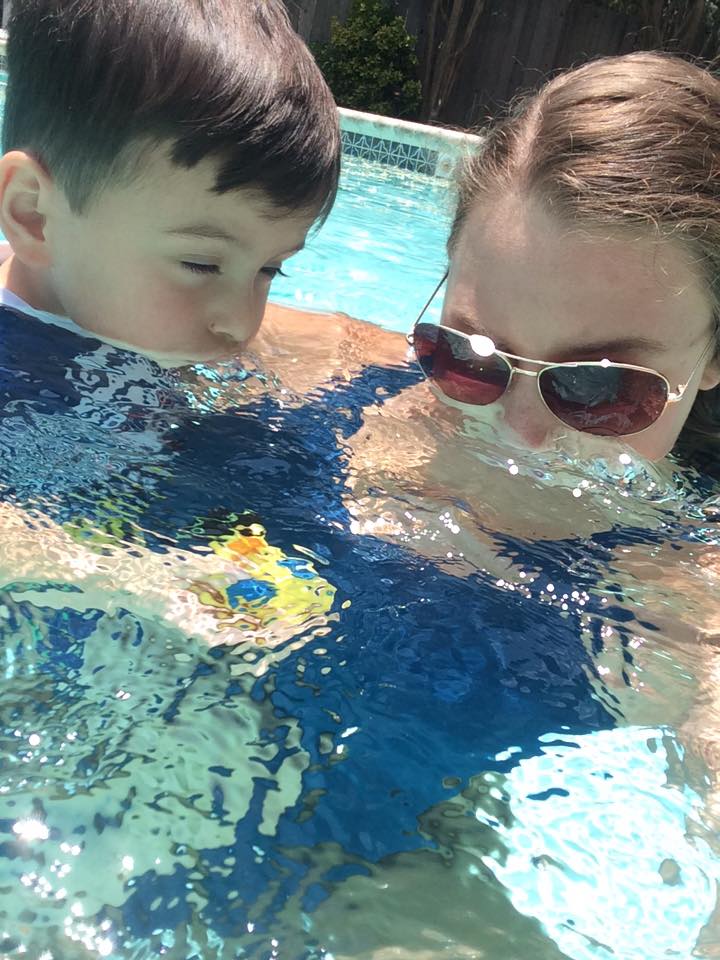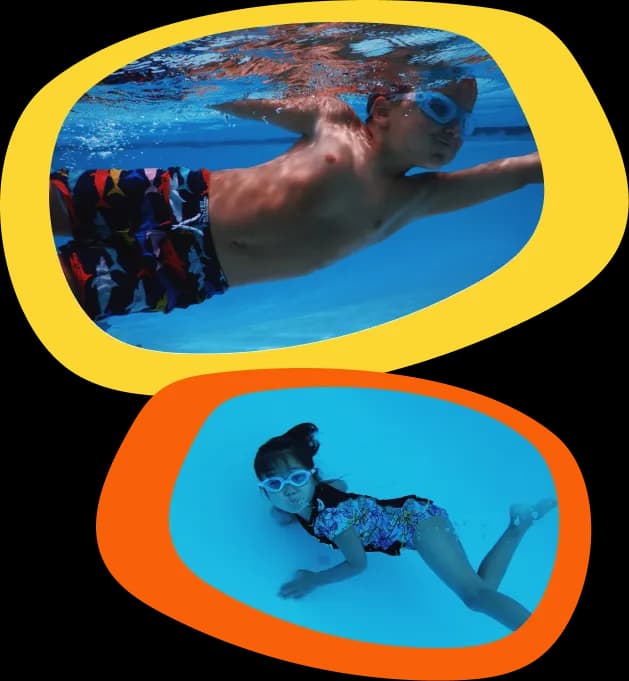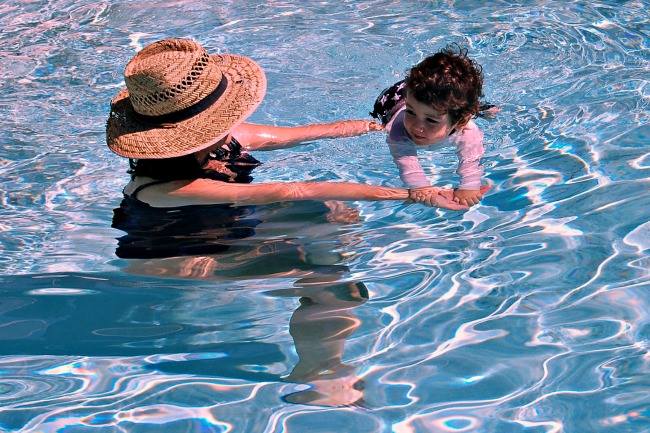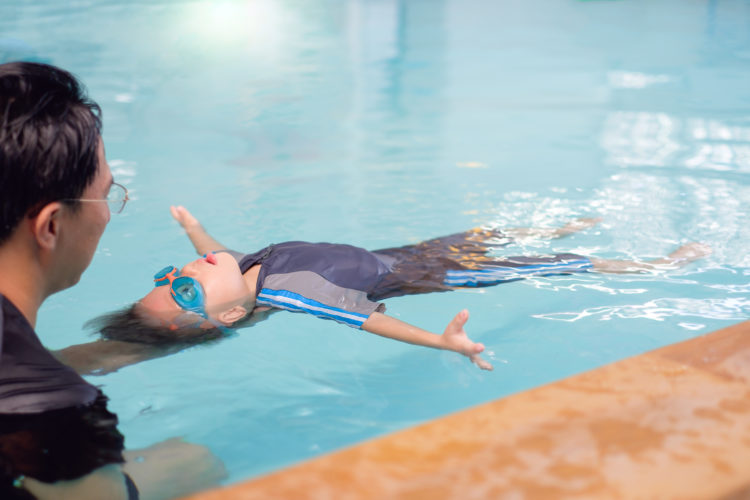Teaching Toddlers to Hold Their Breath

Written by Sunsational — 5 min read


Teaching toddlers to hold their breath under the water is straightforward and fun. Actually, it’s amazing. And, yes, might as well admit there are often tears and fears along the way. But the rewards and health benefits are profound. The three-phase approach below—dryland, above water, and below water—has proven very successful when combined with lesson and practice. Sunsational lessons focus on safety and setting age-appropriate and student-specific goals.
If you’re like me, you’ll probably feel a little weird and a little fearful the first time you see your child go under the water. However, I’ve found that when they first are learning to hold their breath under the water is when we tend to be at our most attentive. So, at the beginning they are completely safe. Later, when they relax about going under the water, we tend to relax, too. That is the time period when we really need to be consciously be diligent. I’ll emphasize this point again at the end.
DRY LAND
Teaching toddlers
To teach a toddler how to hold their breath under water use your knowledge of how toddlers learn in general. Toddlers learn by watching, playing, and following steps. So start with something simple.
Teaching toddlers how to swim
Spend a few afternoons observing your toddler. Really think about how they play and how they learn. Then spend some reading and thinking about how toddlers swim, too. You want to start from a place of relaxation and confidence. You’re being relaxed and calm will naturally evoke those feelings in your child, too.
Diving reflex—breathing under water comes (almost) naturally
It’s helpful to know that children have a diving reflex. This reflex tends to encourage them to hold their breath automatically. Imagine, if you will, finding your head under the water for the first time in your life. The strangeness of that environment—and the fact that it is obviously not air—will encourage you not to try to breathe under there, right? That’s an informal, but helpful way of thinking about it.
Health benefits—belly breathing
When toddlers learn to control their breath, they learn how their mouths and lungs and bellies work together to create their breath. They experience how breathing increases power and energy. Most importantly, they learn how controlled breathing helps them manage their feelings of fear, anxiety, and stress. So, let this be your first step. Lay out in with them—or even let them sit on top of you. Breathe deeply into your belly as they float up. Then hold your breath. Let it whoosh out—let them come tumbling down. Repeat. Then have them lay by your side and try it with you.
ABOVE WATER
Big belly, squirrel cheeks
Now you’re in the water, floating and moving gently with your toddler. Hold them close so they can feel your belly expand as you breathe in deeply. Exaggerate your hold with squirrel cheeks. Connect the breathing in, to the expanded belly, to the squirrel cheeks—so they understand that you are filling your lungs with air—and that air is pushing out your belly.
Release—Motorboat
Showing the release is just as important as the hold, if not more so. So, start with a quick hold of 1-2-3, looking directly at your child as she follows along—or not—counting on your fingers. Then lower your mouth to the surface of the water and blow the air out making a sound like a motorboat. If your child, doesn’t like the splashing this causes, just blow your air out with loose lips, again counting 1-2-3 on your fingers as you do so.
Control—in and out
Emphasize that you can control both how you take air in and how you let air out. Avoid “gasping” or gulping air. Instead, take deep breaths through your nose, touching your nose to show where it is going in. Emphasize your control during the release with the motorboat noise—or by making up any game that you and your child enjoy.
Snort like a pig, sneak like an alligator
Gradually, move the release from your mouth to your nose and from the air to the surface and even slightly below the water. Snort like a pig to emphasize that you are blowing air out of your nose to release it. Many children will not be able to blow out through their nose; however, in making the effort they often can more control over the release through the mouth. Sneak like an alligator with only your eyes above the surface as you release your air by blowing bubbles into the water.
BELOW WATER
Big belly, squirrel cheeks—again
As much as possible, you want this sequence to be performed exactly as you did it above the water—with one exception. You will go under the water, first by yourself, then with your child. Look back at this sequence: this is a good example of using steps, then building toward a complex goal. Fill belly, puff up cheeks, count in, count out—and now go under. Be sure to look your child in the face, count, fill your belly, and your cheeks, and then bring them down with you.
Go deep, stay long
Resist the temptation to stay at the surface. Instead, choose a spot in the pool that when you sit down and go under, both you and your child end up well below the surface. You want to give them the experience of full submersion. Count on your fingers 1-2-3 as you hold. Then lift them back up to the surface and follow them up. The 3-count is not a full three seconds, but it’s not rushed either. It’s not a quick dip. It’s long. Long enough for them to really take in the experience of being under the water.
Wipe face, have talk, repeat
Wipe your face when you surface and ask them about the experience. Ask specific concrete questions. Did you get water in your mouth? Did you open your eyes? How did it feel? Was it scary? Was it fun? Tell them that we practice going under the water so we will know what to do if it happens by accident. It’s important to repeat to help them process the intense influx of new sensations.
While under
Tap your big belly, emphasize your big cheeks. Stay close, so your child can see everything that you’re doing. Be at your most relaxed.
Fears and tears
Many, many children experience fear going under the water. Try not to expect it, but try to be ready for it. Never rush them along into an experience that they are not ready for. However, resistance does necessarily mean that they aren’t ready. Talk openly and directly with your instructor to help you make a determination. When you work with your child, don’t impede his upset. Embrace and congratulate him with a big hug. Let him calm down, then ask specific questions. Was it fun? Was it scary? Sometimes even children who experience a lot of upset also find the experience fun. Just as in adults, these feelings are not mutually exclusive.
Okay or too much
I have a few “rules of thumb” I use when trying to make a determination was it upsetting but “okay” or is it really “too much.” How quickly does the child recover from her upset? Does she stay in the pool? Is the pool still a fun place for her to play? If the upset continues or the child leaves the pool and refuses to return or if she rejects the pool as an un-fun place, each one of those is a signal that the underwater experience was too much. It’s fine—and even good—to back off. Work with the child to find a place of comfort and fun, again.
Duck diving
Many children also prefer duck diving to simply sitting down into and under the water. Duck diving is when you gently but firmly propel your child under the water toward another adult who catches them under the water. This motion is exciting—and the rush of water over the face helps stimulate holding their breath. Repeat, but only once at first. These are exciting—and therefore—exhausting experiences.
Holds and releases—Bubble control
As important as it is to hold our breath under the water, it’s equally if not more important to learn to release our breath into the water. This release is more like air-breathing and keeps us relaxed under the water. This is where all your bubble work comes in! Blowing bubbles in the air, at the surface, and then under the water is how we release our breath into the water. Encourage this by blowing big bubbles from your mouth whenever you are under the water with your child. Smile, play, have fun with your bubbles to emphasize how much blowing bubbles relaxes you under the water. In a way, this is an “advanced” skill. However, I have found many children start doing it quite early in their underwater career if it is consistently modeled to them.
Watch
Spend time watching your child under the water. Blow bubbles at them. Blowing bubbles increases our relaxation under the water. It’s kind of like humming, but it’s also more like what happens in the air. We slowly leak air all the time. We don’t take a breath, hold it, and then take another breath.
Review
So, what steps did you take to help your toddler learn to hold her breath under the water? On dryland, you modeled breathing deeply into your belly—and then showing how you could control the release of it. Above water, you left them feel your belly fill with air as you puffed up your squirrel cheeks. You counted 1-2-3 as you held and 1-2-3 as you released. You let them practice those holds and releases with you. You moved your releases into your pig snorts and alligators sneaking just under the surface of the water with only your eyes exposed. You held your child in your lap—and did it all over again—but this time taking them below. You helped them work through their resistance and fear. You duck dived with them. You asked them if they got water in their mouths. You asked them how they felt about going under.
Crossing the threshold—a dangerous time
You and your child have worked hard to master holding your breath under the water. Now—often suddenly—the day has arrived that your child not only does it, but they do it comfortably and even playfully. When our child crosses this threshold, when he puts his head and face under the water voluntarily and constantly during play, when being underwater goes from a place that is fearful to a place that is fun, this is when we must be the most attentive. Why? Because their comfort leads to moments of inattention where they swallow water and choke. We need to be right there, watching closely. We have to show that when you feel yourself choke, you need to kick up to the surface before you try to get a breath. We have to resist the urge to get overly relaxed at this stage—because they will not always be able to resist the urge to feel and act in overconfidence.

About the Author: Robert Rogers
Robert is a Sunsational Swim Instructor in Santa Rosa, California.
In his work life, Robert has taught people how to sing, act, and swim—and birds how to fly. Okay, well not exactly. But he did train birds for shows at state fairs, zoos, and Disney’s Animal Kingdom. His only regret is not having learned how to fly himself—yet! You have to crawl before you can fly—or butterfly, right? Favorite animal movie of the moment: EIGHT BELOW!
Book your lesson with Robert or any of our swim instructors!
Share on socials




